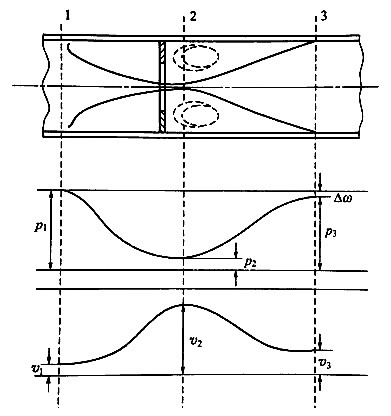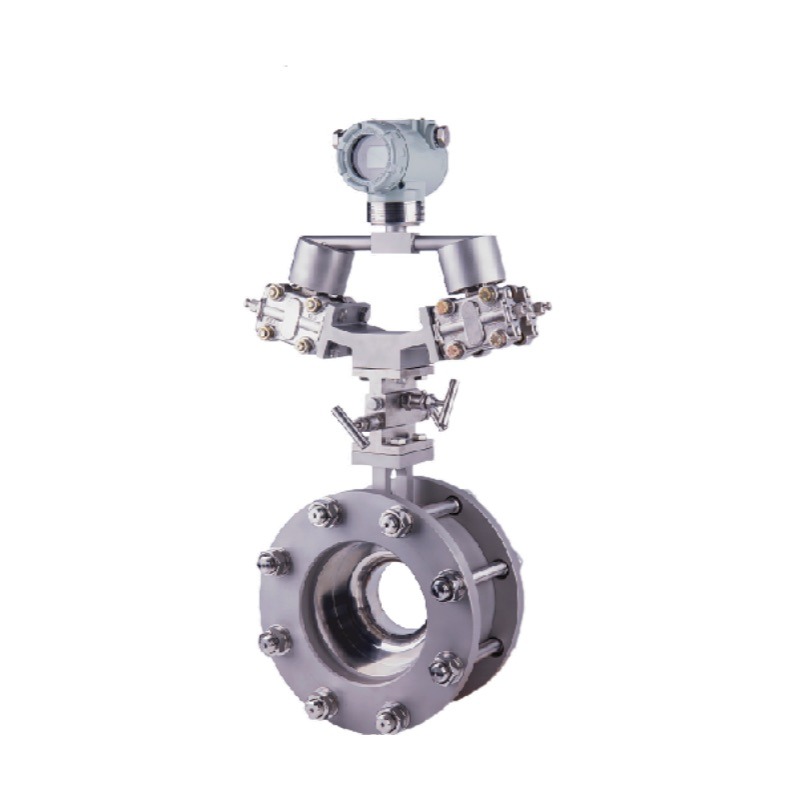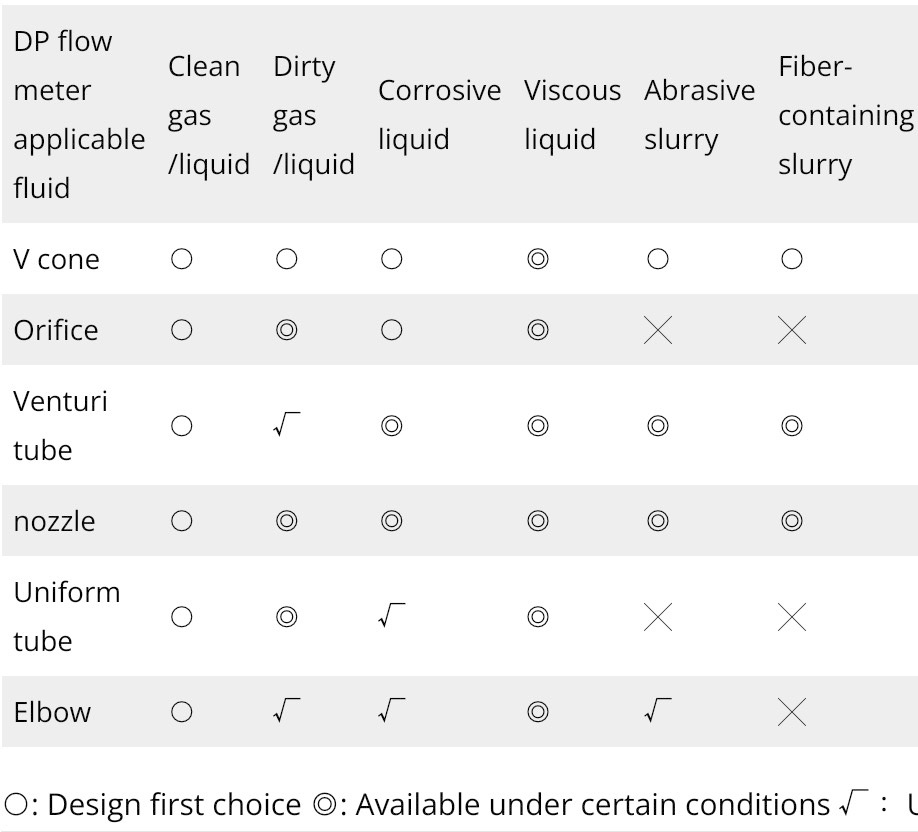Differential Pressure Flow Meter is also called DP flow meter. Differential pressure flow meters use the principle of differential pressure to measure the flow of liquid, gas and steam.
Differential pressure flow meter working principle
When the fluid flows through the throttle, the fluid will be accelerated due to the fluid being compressed.
As the velocity of the fluid increases, the kinetic energy of the fluid will increase accordingly.
According to the law of conservation of energy, we know that the static pressure of the fluid being accelerated will reduce the corresponding value.

The cross-sectional area of the pipe at cross-section 1 is A1. The average flow velocity of the fluid when flowing through the cross section A1 is V1. Its density is ρ1.
When the fluid flows through cross section 2. The average flow rate of the fluid becomes V2. The density is ρ2. The cross-sectional area is A2.
According to the principle of fluid flow continuity, there is the following relationship: V1×A1×ρ1=V2×A2×ρ2.
If the fluid is a liquid, the density of the fluid before and after compression is generally considered constant. That is, ρ1=ρ2=ρ.
Therefore, the volumetric flow rate of the liquid: qv=V1×A1=V2×A2 ——–Formula①
According to the Bernoulli equation (i.e. the law of conservation of energy), Z1=Z2 on a horizontal pipe, then the following relationship is given:

Applying the Bernoulli equation and the principle of flow continuity, there are the following relations on the two cross sections:

From formula ①, we get: V1=A2/A1×V2; put formula ① and formula ② into formula ③ to get:

In the above formula: A1=(πD2)/4, A2=(πd2)/4, according to the definition of the diameter ratio according to the diameter ratio β: β=d/D. From formula ①, we can get: V2=qv/A2
Therefore: The theoretical flow formula can be derived from this:

Also defined by the outflow coefficient C is: C=actual flow/theoretical flow,
Finally, the calculation formula of differential pressure flowmeter can be obtained:

The expansibility coefficient of ε measured medium in formula ⑥, generally speaking ε=1 for liquid.
It can compress fluid ε<1 for gas, steam, etc.
qv is the volume flow of the fluid, unit: m3/s).
ρ1 is the density of the fluid upstream of the throttle (front) under working conditions, in kg/m3.
d is the equivalent opening diameter of the throttle under working conditions, unit: m.
△P is differential pressure, △P=P1-P2, unit: Pa.
types of differential pressure flow meter
1. FMD-PH orifice plate flowmeter: standard orifice plate can be used to measure the flow of liquid, gas and steam in the pipeline. It is the most widely used flowmeter in fluid measurement, and its disadvantage is the large pressure loss.
2. FMD-NZ nozzle flowmeter: standard nozzle is also called ISA1932 nozzle. It has the characteristics of high temperature and high pressure resistance, impact resistance, long service life, large measurement range and high measurement accuracy. It is suitable for high temperature and high pressure steam in power plants, heat network pipes, and large flow fluid flow measurement.
3. FMD-SL dual-range differential pressure flowmeter: Dual-range flowmeters usually use two differential pressure sensors of high range and low range.
4. FMD-B constant velocity tube flowmeter: The constant velocity tube flowmeter, also called bar flowmeter, is a flowmeter designed and manufactured according to the pitot tube principle for measuring the pressure of fluid (gas, steam, liquid, etc.) to measure flow.
5. FMD-XX wedge flowmeter is a flowmeter that measures flow through V-shaped throttling element. It is used for solid-containing liquid media such as mud, mineral pulp, sandy crude oil, sewage, heavy oil, residual oil, etc. It can also be used for flow measurement of gas and steam media, especially for dirty gas and natural gas flow measurement.
6. FMD-NT V-cone flowmeter (V-corn flowmeter) differential pressure flowmeter, which uses V-cone to produce throttling effect in the flow field to measure flow. The V-cone flowmeter has the advantages of high long-term use accuracy, high repeatability, small installation conditions, wear resistance, wide measurement range, suitable for dirty media, and small pressure loss.
What is the orifice plate flow meter ?
Orifice plate flow meter works together with an orifice plate, differential pressure transmitter, with Differential Pressure Measurement principle. Easy installation. Orifice plate flow meters can be used with gases, liquids, corrosive, and high temperature fluids. Orifice flow meters can measure steam, gas, liquids, and many industrial areas. Applications include steam flow, boiler feedwater, and fluid flow rates in building water lines.

Why are orifice flow meters also called differential pressure flow meters?
Orifice flowmeter is a flow measurement instrument, mainly used for flow measurement, such as measuring liquid, gas, etc., it can solve almost all flow measurement problems, orifice flowmeter has a unique advantage, that is, its high temperature resistance characteristics , can solve the high temperature working condition of 700 degrees.
Why is the orifice flowmeter also called differential pressure orifice flowmeter? , not only high temperature resistance, but also highlights its advantages in high pressure measurement conditions.
Orifice plate flowmeter is a high-range ratio differential pressure flow device composed of standard orifice plate and multi-parameter differential pressure transmitter (or differential pressure transmitter, temperature transmitter and pressure transmitter), which can measure gas, Steam, liquid and induced flow.
What is a annubar flow meter?
Annubar flow meter is a differential pressure flow meter. Annubar flowmeter (also known as flute equalizing velocity tube flowmeter) is a new type of differential pressure flow detection element developed according to the principle of pitot tube velocity measurement. Its output is a differential pressure signal, which is matched with instruments for measuring differential pressure. It can accurately measure the flow of various liquids, gases and steam (superheated steam and saturated steam) in circular pipes and rectangular pipes, and gradually replace orifice plates and other Detection elements are widely used in power industry (including nuclear industry), chemical industry, petroleum and metal smelting and other industries.
What is a wedge flowmeter ?
Wedge flowmeter is a new type of throttling differential pressure flow measuring instrument. The wedge flowmeter can perform high-precision flow measurement in fluids with high viscosity and low Reynolds number (Reynolds number 500 can be used). It has unparalleled advantages in flow measurement occasions with low flow rate, small flow and large pipe diameter. Except for general gas, liquid and steam, it is especially suitable for flow measurement of high-viscosity, dirty liquid and high-dust gas.
DIFFERENTIAL PRESSURE FLOW METER APPLICATION
The high turndown ratio differential pressure flow device composed of the shut-off device and the multi-parameter differential pressure transmitter (or differential pressure transmitter, temperature transmitter and pressure transmitter) can measure the flow of gas, steam, liquid and natural gas. , widely used in process control and measurement in petroleum, chemical, metallurgy, electric power, heating, water supply and other fields.
Differential pressure flowmeter model type selection:


Why are orifice flow meters also called differential pressure flow meters?
Orifice flowmeter is a flow measurement instrument, mainly used for flow measurement, such as measuring liquid, gas, etc., it can solve almost all flow measurement problems, orifice flowmeter has a unique advantage, that is, its high temperature resistance characteristics , can solve the high temperature working condition of 700 degrees.
Why is the orifice flowmeter also called differential pressure orifice flowmeter? , not only high temperature resistance, but also highlights its advantages in high pressure measurement conditions.
Orifice plate flowmeter is a high-range ratio differential pressure flow device composed of standard orifice plate and multi-parameter differential pressure transmitter (or differential pressure transmitter, temperature transmitter and pressure transmitter), which can measure gas, Steam, liquid and induced flow.
Read more: differential pressure transmitter for flow measurement











